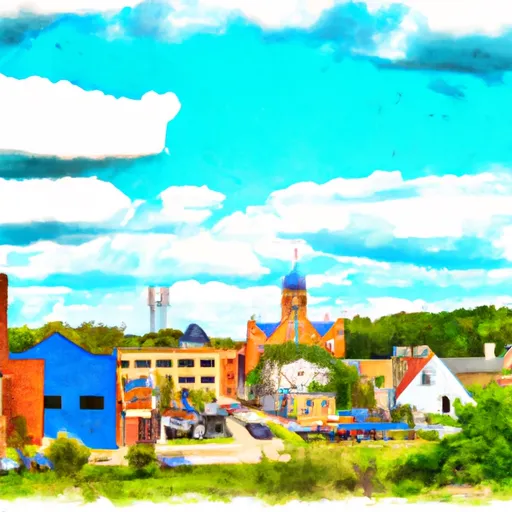-
 Snoflo Premium
Snoflo Premium
Get unlimited access to all our content
With no Ad interruptions! - Start Your Free Trial Login with existing account
Vicksburg
Eden Index
Climate
7.8
•
Recreation
3.8
•
Community
3.0
•
Safeguard
5.2/10

Vicksburg, Michigan, is a charming village located in Kalamazoo County. It experiences a humid continental climate, characterized by warm summers and cold winters. Average high temperatures in July reach around 83°F (28°C), while January lows can drop to 18°F (-8°C). The area receives moderate rainfall throughout the year, with an average of 36 inches annually.
Vicksburg is blessed with a diverse hydrology, boasting numerous lakes and rivers. Barton Lake, Sunset Lake, and Indian Lake are popular destinations for fishing, boating, and swimming. The nearby Portage Creek and Prairie River provide scenic views and opportunities for kayaking and canoeing.
The village offers various outdoor recreational activities. Vicksburg Trailway is a multi-use trail that spans over nine miles, ideal for walking, running, and biking. The local parks, such as Vicksburg Historic Village, Clark Park, and Sunset Lake Park, provide excellent spots for picnicking, playing sports, and enjoying nature. Furthermore, the nearby Prairie View County Park features hiking trails, a disc golf course, and a dog park.
Overall, Vicksburg, Michigan, is a picturesque village with a pleasant climate, abundant water resources, and diverse outdoor recreation options, making it an ideal destination for nature enthusiasts and outdoor lovers.
What is the Eden Index?
The Snoflo Eden Index serves as a comprehensive rating system for regions, evaluating their desirability through a holistic assessment of climate health, outdoor recreation opportunities, and natural disaster risk, acknowledging the profound impact of these factors on livability and well-being.
Climate Health Indicator (CHI): 7.8
Vicksburg receives approximately
962mm of rain per year,
with humidity levels near 80%
and air temperatures averaging around
10°C.
Vicksburg has a plant hardyness factor of
6, meaning
plants and agriculture in this region thrive during a short period during spring and early summer. Most
plants will die off during the colder winter months.
By considering the ideal temperature range, reliable water supplies, clean air, and stable seasonal rain or snowpacks, the Climate Health Indicator (CHI) underscores the significance of a healthy climate as the foundation for quality living.
A healthy climate is paramount for ensuring a high quality of life and livability in a region, fostering both physical well-being and environmental harmony. This can be characterized by ideal temperatures, reliable access to water supplies, clean air, and consistent seasonal rain or snowpacks.
Weather Forecast
Streamflow Conditions
Area Rivers
Snowpack Depths
Reservoir Storage Capacity
Groundwater Levels
Recreational Opportunity Index (ROI): 3.8
The Recreational Opportunity Index (ROI) recognizes the value of outdoor recreational options, such as parks, hiking trails, camping sites, and fishing spots, while acknowledging that climate plays a pivotal role in ensuring the comfort and consistency of these experiences.
Access to outdoor recreational opportunities, encompassing activities such as parks, hiking, camping, and fishing, is crucial for overall well-being, and the climate plays a pivotal role in enabling and enhancing these experiences, ensuring that individuals can engage in nature-based activities comfortably and consistently.
Camping Areas
| Campground | Campsites | Reservations | Toilets | Showers | Elevation |
|---|---|---|---|---|---|
| Lake Clare Park Camp | 18 | 746 ft | |||
| Chain OLakes State Park | 410 | 956 ft | |||
| Salamonie State Lake - Lost Bridge West SRA | 250 | 794 ft | |||
| Nottawa Park | 20 | 831 ft | |||
| Cade Lake County Park | 62 | 869 ft | |||
| Cold Brook County Park | 51 | 941 ft | |||
| Mt. Etna State Rec Area | None | 819 ft | |||
| Hidden Diamonds City Park | None | 901 ft | |||
| Lost Bridge State Rec Area - Salamonie Lake | None | 794 ft | |||
| Kil-So-Quah - J. Edward Roush Lake | 90 | 807 ft |
Nearby Ski Areas
Catastrophe Safeguard Index (CSI):
The Catastrophe Safeguard Index (CSI) recognizes that natural disaster risk, encompassing floods, fires, hurricanes, and tornadoes, can drastically affect safety and the overall appeal of an area.
The level of natural disaster risk in a region significantly affects safety and the overall livability, with climate change amplifying these risks by potentially increasing the frequency and intensity of events like floods, fires, hurricanes, and tornadoes, thereby posing substantial challenges to community resilience and well-being.
Community Resilience Indicator (CRI): 3.0
The Community Resilience Indicator (CRI) recognizes that education, healthcare, and socioeconomics are crucial to the well-being of a region. The CRI acknowledges the profound impact of these elements on residents' overall quality of life. By evaluating educational resources, healthcare accessibility, and economic inclusivity, the index captures the essential aspects that contribute to a thriving community, fostering resident satisfaction, equity, and social cohesion.

